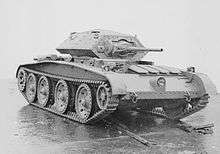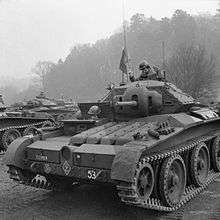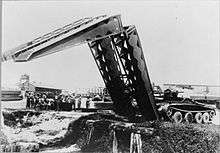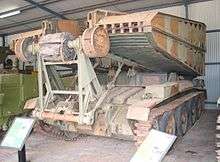Covenanter tank
| Covenanter cruiser tank | |
|---|---|
|
Tank, Cruiser, Mk V, Covenanter (A13 Mk III) | |
| Type | Cruiser tank |
| Place of origin | United Kingdom |
| Service history | |
| In service | 1940-1943 |
| Production history | |
| Designer | LMS/Nuffield (turret) |
| Manufacturer | LMS, English Electric Leyland Motors |
| Number built | 1,771 |
| Specifications | |
| Weight | 18 long tons (18 t)[1] |
| Length | 19 ft 0 in (5.79 m)[1] |
| Width | 8 ft 7 in (2.62 m)[1] |
| Height | 7 ft 4 in (2.24 m)[1] |
| Crew | 4 (commander, gunner, loader, driver) |
|
| |
| Armour | 7–40 mm (0.28–1.57 in) |
Main armament | QF 2-pounder (40 mm) |
Secondary armament | 7.92 mm Besa machine gun (coaxial) |
| Engine |
Meadows D.A.V flat-12 340 hp (250 kW) |
| Power/weight | 18.6 hp (13.9 kW) / tonne |
| Transmission | Meadows gearbox with Wilson epicyclic steering |
| Suspension | Christie |
| Fuel capacity | 92 imperial gallons (420 l)[2] |
Operational range | 100 mi (160 km)[1] |
| Speed | 30 mph (48 km/h) |
The Tank, Cruiser, Mk V or A13 Covenanter was a British cruiser tank of the Second World War. The Covenanter was the first cruiser tank design to be given a name. Designed by the London, Midland and Scottish Railway as a better-armoured replacement for the Cruiser Mark IV, it was ordered into production in 1939 before pilot models were built. Problems with the design only became apparent after production was under way.
The tank equipped various British armoured divisions in the home defence and training roles. It never left the British Isles as poor engine cooling caused versions MkI-MkIII to be declared unfit for use overseas service especially in hot climates. This was rectified in the MkIV after many corrective actions were undertaken but by February 1944, it was declared obsolete. More than 1,700 of the type were built.
It was named after the Covenanters, a Scottish religious faction in the British Isles at the time of the Wars of the Three Kingdoms.
Development

In 1938, the War Office had issued a requirement for a new, better armoured "heavy" cruiser tank to replace the Cruiser IV. Nuffield's A16 (and the A14) design was found to be too expensive and, in 1939, a cheaper and lighter cruiser tank - under General Staff specification A13 Mk III Cruiser Mark V - was chosen to be developed. It had nothing apart from Christie suspension and armament in common with the other A13 specifications.[3]
The initial specification required a QF 2 pounder gun, at least one machine gun, the same A13 Christie suspension in a lower hull,[4] epicyclic steering transmission and "armour standard" of 30 millimetres (1.2 in). The "30 mm armoured standard" referred to any vertical plate having to be 30 mm thick. Angled surfaces (through the principles of sloped armour) could be thinner, provided they were at least as effective as a 30 mm thick vertical plate.
From these, a design using many sloped surfaces was chosen to keep the weight low. To keep the silhouette low, the suspension used cranked arms and a low profile engine was envisaged. The engine, which was to be specifically designed for it, was to deliver at least 300 horsepower (220 kW). The Wilson transmission and steering of the A16 would be used.[5]
Design work was by the London, Midland and Scottish Railway Company (LMS). They had no prior experience in the design and production of fighting vehicles,[note 1] they had been invited to participate under a Government policy that British companies should develop necessary skills in expectation of war.[6] The design assumed a welded hull rather than the usual rivetting. The turret was designed by Nuffield, with Henry Meadows designing a new low profile engine for it. On 17 April, before even a single prototype was produced, the first 100 vehicles were ordered from the LMSR. Additional orders soon followed, with English Electric and Leyland Motors joining the production effort, for a final production total of 1,771 Covenanters.[7][8] Nuffield was also approached, but preferred to design its own offspring of the A13 line, which became the Cruiser Mk.VI Crusader.
Due to the expectations of an imminent war, the design was ordered "off the drawing board". The expectation was that two pilot models would serve for testing and results applied to the production lines.
To meet the engine requirement, a horizontally opposed 12-cylinder design was used. Although flat, it was wide and left no room for radiators in the engine compartment, and so the radiators were situated at the front of the vehicle. The unusual arrangement, although tested in mockup form first, when combined with the rushed design process resulted in serious problems with engine cooling. Even when the systems were redesigned there were problems, and the piping from engine to the radiators heated the fighting compartment. These problems meant that the Covenanter would not be employed in the North African Campaign. Instead, Crusader and American tanks were sent to Africa, while the Covenanters remained in the British Isles.
LMS advised a return to riveted construction due to doubts about its strength, and rather than risk delays due to a lack of welders, this was accepted. The welded design used two layers of armour plate, the inner being of steel that would weld readily without losing its properties. This two-plate system was retained when the design reverted to riveted construction. The use of riveted construction, the use of steel wheels instead of the intended aluminium[note 2] and an increase in armour specification to 40 millimetres (1.6 in) at the front of hull and turret increased the weight to a level where the tank suspension was at maximum load, leaving no room for later development of the design.[5]
A further change was made to the transmission. Rather than risk the availability of the combined Wilson transmission and steering affecting production, the A13 "crash" gear box was used with epicyclic steering units. This had the knock-on effect of a reduced size of cooling fan for the transmission compartment.[9]
The contracts were placed with the manufacturers in 1939. The pilot model (with welded hull) was tested with a favourable outcome in 1940; though the second pilot had cooling issues. The first deliveries of production vehicles were not until after the battle of Dunkirk. Production of turrets lagged behind that of hulls. Although the Covenanter was needed at the time, production continued even when newer better tank designs were waiting for space on production lines.[10]
By late 1943, the Covenanter was considered too weakly armed and armoured to deal with new German tanks. It was decided that neither problem could be addressed without significant changes in the design, so the tank was declared obsolete and all vehicles except the bridgelayer variant were to be scrapped.[7][11]
Active service

Except for a few trial vehicles, Covenanters were never deployed outside the British Isles. The Covenanter was used to re-equip the British 1st Armoured Division (six armoured regiments in two brigades), which had lost most of its tanks in the Fall of France. When the 1st was sent to Egypt, the tanks were transferred to the 9th Armoured Division.[7]
Eventually, a handful of vehicles were sent to the desert for service trials and were allocated to the REME for maintenance and evaluation. It is not clear if these tanks were ever used in combat, although the unit markings indicate they may have been deployed alongside Kingforce with their new 6 pounder-equipped Churchill Mk III tanks.
Covenanters were also used to equip the Guards Armoured Division in 1942 and elements of the 1st Polish Armoured Division when it was formed in the UK; they were replaced before these units were sent to the front-line, except for a few bridgelayers both divisions retained and used in their advance through Belgium and the Netherlands. The only Covenanter gun armed tank known to have been lost to enemy action was that destroyed by a German air raid on 31 May 1942 in Canterbury.
The Covenanter was declared obsolete in 1943 with orders for the tanks to be scrapped, except for those modified for auxiliary roles.
Observation Post tanks were issued to artillery units to carry Forward Observation Officers for Royal Artillery batteries. In an armoured division, there were two OP tanks for each RHA or field battery. Medium gun batteries had just one. Command tanks were similar to OP tanks, but had only two No. 19 sets – one on the regiment radio net and the other on the brigade net.
Covenanter bridgelayers were used by the 1st Czechoslovak Armoured Brigade during the siege of Dunkirk from October 1944 to May 1945.[12] The bridgelayer version was also used by the 4th Armoured Brigade of the Australian Army at Bougainville and Balikpapan during the Pacific Campaign in 1945.[13]
Variants

- Covenanter Mk I (Cruiser Mk V) - Original production model.
- Covenanter Mk I Close Support - Armed with 3-inch howitzer.
- Covenanter Mk II (Cruiser Mk V*) - Mark I production modified by addition of radiator-mounted oil cooler.
- Covenanter Mk II CS - Armed with 3-inch howitzer.
- Observation Post version existed with dummy gun, two No. 19 radios and a No. 18 radio;[note 3] issued to artillery units.
- Command version existed with dummy gun and two No. 19 radios.
- Covenanter Mk III (Cruiser Mk V**) - new production with twin oil coolers installed either side of the engine. Clutch linkage modified. Air cleaners added inboard at the rear. Exhaust silencers moved to the ends of the track guards.
- Covenanter Mk III CS - Armed with 3-inch howitzer.
- Covenanter Mk IV - New production as the Mk II with the clutch changes of the Mk III.
- Covenanter Mk IV CS - Armed with 3-inch howitzer.
- Observation Post version existed with dummy gun, two No. 19 radios and No. 18 radio.
- Covenanter Bridgelayer - Covenanter hull fitted with a vehicle-launched bridge ("30 ft No. 1"). This was 34 feet (10 m) long and 9 feet 6 inches (2.90 m) wide. It could span a 30-foot (9 m) gap and was capable of carrying 24 tons.[14] In 1944, an improved bridge was developed with a 30-ton capacity.
- Covenanter ARV Mk I - Armoured recovery vehicle based on turretless Covenanter hull. One prototype was built in 1942.
Additional equipment:
- Anti-Mine Roller Attachment (AMRA) Mk IC - a mine clearing device consisting of four heavy rollers suspended from a frame. The weight of the rollers could be increased by filling them with water or sand.
Surviving vehicles
.jpg)

A single Covenanter gun–tank is preserved at The Tank Museum, Bovington, in the United Kingdom. It is displayed in the markings it had during the War when it served with the 13th/18th Royal Hussars, part of the 9th Armoured Division. For unknown reasons, it was buried after the war on a farm near Dorking. In the early 1980s it was discovered, recovered, restored and put on display at the Bovington museum.[2] The Tank Museum also has the turret from an early Covenanter pilot model.[15] The partially buried, wrecked hulls of two other tanks may be seen at Titchwell Marsh in Norfolk, UK.[16] Now a Royal Society for the Protection of Birds nature reserve, the area was formerly a tank gunnery range and the Covenanters were likely used as targets.[17]
Two Covenanter Bridgelayers are preserved in Australia – one at the Royal Australian Armoured Corps Tank Museum, Puckapunyal, Victoria, and one at the 1st/15th Royal New South Wales Lancers Lancer Barracks and Museum at Parramatta, New South Wales.[18]
Notes
References
- Citations
- 1 2 3 4 5 White p47
- 1 2 Mike Garth. "Tank Cruiser Mark V** A13 (E1985.30)". Bovington Tank Museum. Retrieved 4 November 2011.
- ↑ Fletcher, Great Tank Scandal, p. 60.
- ↑ Bingham, James, AFV Profile No. 8 Crusader-Cruiser Mark VI, Windsor: Profile Publishing
- 1 2 Fletcher and Sarson p4
- ↑ White, B T p. 47
- 1 2 3 Tanks of World War II, Steve Crawford, Brown Partworks Ltd 2000 ISBN 0-7603-0936-1 (p 51)
- ↑ Bigham quotes 1,365 Covenanters
- ↑ Fletcher and Sarson p6
- ↑ Fletcher, Great Tank Scandal, p. 62.
- ↑ Fletcher, Great Tank Scandal, p. 43.
- ↑ Czechoslovaks at Dunkirk 1944-45 by Jan Hyrman Archived 14 July 2011 at the Wayback Machine.
- ↑ Website of the Royal New South Wales Lancers Lancer Barracks and Museum - Covenanter Bridgelayer Retrieved August 2013
- ↑ Crusader Cruiser Tank p36
- ↑ Braun, p40
- ↑ Braun, p5
- ↑ "Titchwell Marsh Before the RSPB". Briarfields Norfolk Hotel. Retrieved 16 November 2010.
- ↑ Braun, p4
- Bibliography
- B. S. Barnes, The Sign of the Double 'T' (The 50th Northumbrian Division – July 1943 to December 1944), Market Weighton: Sentinel Press, 2nd Edn 2008, ISBN 978-0-9534262-0-1.
- Pierre-Olivier Buan (25 October 2011). "Surviving Cruiser Tanks" (PDF). Surviving Panzers website. Retrieved 5 November 2011.
- Major L. F. Ellis, History of the Second World War, United Kingdom Military Series: Victory in the West, Vol I: The Battle of Normandy, London: HM Stationery Office, 1962/Uckfield: Naval & Military, 2004, ISBN 1-845740-58-0.
- David Fletcher, Peter Sarson - Crusader Cruiser Tank 1939–1945, 2000 Osprey Publishing (New Vanguard 14), ISBN 1-85532-512-8.
- Fletcher, David (1989). The Great Tank Scandal: British Armour in the Second World War - Part 1. HMSO. ISBN 978-0-11-290460-1.
- Fletcher, David (1989). Universal Tank: British Armour in the Second World War - Part 2. HMSO. ISBN 0-11-290534-X.
- B. T. White, British Tanks 1915-1945 Ian Allen.
External links
| Wikimedia Commons has media related to Covenanter tank. |
